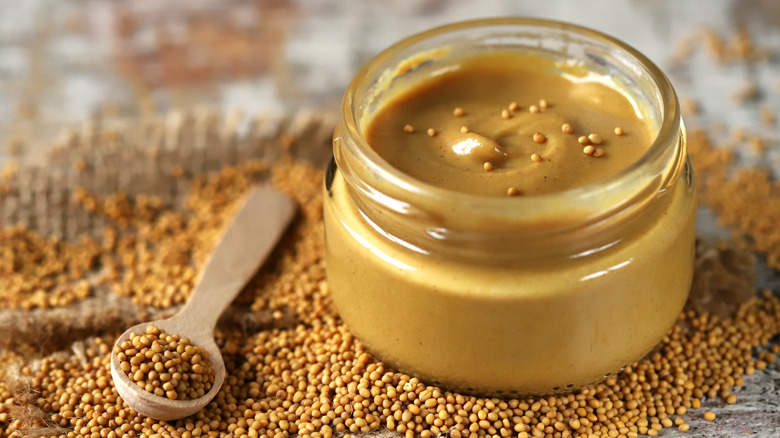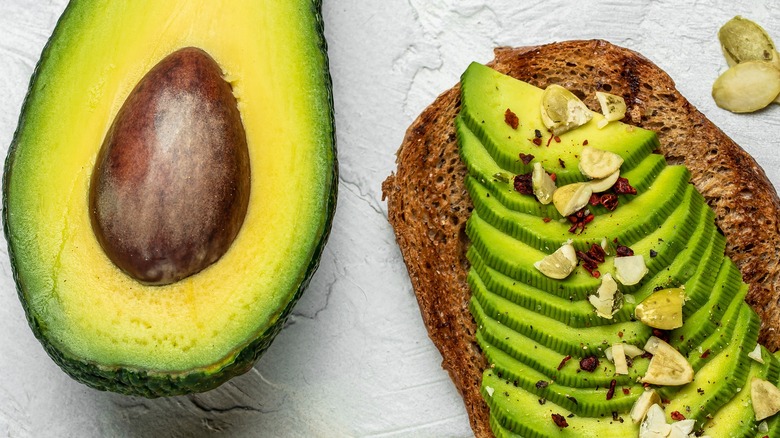12 Common Foods That Can Cause An Allergic Reaction
We rightly expect the food we eat to nourish and sustain us throughout our lives. But sometimes, what we eat can cause us some serious trouble. Allergic reactions caused by food are far from uncommon, and in the U.S. alone, 32 million individuals live with food allergies, with over 10% of American adults needing to omit specific foods from their diets (via the Asthma and Allergy Foundation of America). What's more, despite the rapid pace of increasing food technology and advances in medicine, food allergies are on the rise in certain groups, notably in children, and allergies that used to be rare, like sesame allergies, are now commonplace.
As such, there's an increasing need to be aware of allergic reactions and the foods that cause them — not just for our own safety, but for the safety of others who we might be feeding or preparing food with. While some food allergies are well-known, others may be a little less apparent, and certain foods that we think might be innocuous may actually be pretty harmful. That's why we put together a list of the most common foods that can cause an allergic reaction.
Cod
Cod is, on the surface, a seemingly harmless food, delivering a great amount of protein and with numerous potential health benefits (per WebMD). But the white fish, alongside other common varieties of fish, is a common allergic trigger.
Fish allergies are generally more likely in areas that consume more fish, and can be triggered regardless of how the fish is eaten, thanks to the heat-stable parvalbumin proteins that reside in fish flesh that cause the allergic response (per ECARF).
Generally, fish allergies will not be specific to just one type of fish, although there is the potential for folks to have mono-allergies, meaning that only one fish variety will result in symptoms. Cod is a particular allergic trigger due to the concentration of parvalbumin being higher in white fish flesh, meaning that fish with darker flesh, like tuna or salmon, may be less troublesome to eat. Allergic responses to fish will vary in symptoms and severity from person to person, with the mouth, abdominal area, and the skin all potentially showing a response. In severe cases, fish allergies can result in breathing difficulty and anaphylactic shock, necessitating immediate medical attention.
Granola bars
Granola bars are one of life's great conveniences: Easy to pack into a gym bag or a lunch box, they provide quick and lasting energy at a low cost. However, people with peanut allergies would do well to steer clear of granola bars, as the nut can show up frequently in them.
A highly common allergy, peanut allergies occur when your immune system responds to the presence of peanut proteins, releasing an allergic response that can be serious and even life-threatening (per the Mayo Clinic). Individuals with peanut allergies can be triggered by consuming or touching peanuts, through cross-contamination from other foods or sources, or even by inhaling peanut particles – which is why if you've ever been on a plane where an announcement is made about the nuts not being served due to an allergy, you know you should take it seriously.
Luckily, though, if you have a peanut allergy, granola bars aren't completely off the menu. You just have to be careful about which ones you buy. Spike's Baking Raw Organic Coconut Bars and Made Good Chocolate Banana Granola Bars are both made in a peanut-free facility and have no peanuts in their ingredients, as Green Choice Now discusses. It's highly important to check all food products for peanuts if you have an allergy (or if you'll be eating with someone who does).
Shrimp
For such a small creature, the shrimp can cause a lot of trouble. Shrimp, along with other shellfish, are very common allergic triggers amongst both adults and children, with around 2% of people in the United States living with a shrimp allergy, says the Food Allergy Research & Education (FARE). Caused by the proteins that reside in shellfish, an allergic response can occur even with the smallest of contact, with anaphylaxis a potential outcome.
Shrimps belong to the crustacean family of shellfish (which also includes lobster, crab, and prawns), with the other group of shellfish, bivalves or mollusks, comprising squid, octopus, oysters, scallops, and others. Your allergy might only be triggered by one of these groups, or by specific seafood within these families. It's useful to remember that shellfish allergies are different from fish allergies, and so it might be the case that you can eat one and not the other. However, given that fish and shellfish are often handled or sold in environments with each other, it's vital to be on guard for any cross-contamination that could occur.
Bread
For some people, bread is one of life's great pleasures, but for other people, it's a source of potential trouble. Bread may seem harmless, but it's a site of two potential allergic triggers: Egg and wheat.
Egg allergies are less common in adults, but in children, they are especially prevalent, and some people may carry an egg allergy through their entire lives (via the Mayo Clinic). Generally, it's the whites of the egg that are more likely to cause a reaction, although egg yolks may also generate a response — and in the case of bread, where whole eggs are frequently used, it may be hard to discern the difference. A frequent symptom of egg allergies is surface-level, with skin breaking out in hives or becoming red and inflamed.
Wheat is the main component of bread, and so it's best left avoided by those with wheat allergies. As with egg allergies, wheat allergies are especially common in children, with around 1 in 100 people under 12 experiencing a response to wheat (per FARE). It's important to note that wheat allergies may cause anything from hives to gastrointestinal issues. With symptoms having the potential to become severe and dangerous — and with both wheat and eggs common components in a huge range of foods — it's vital to practice caution.
Ice cream
Ice cream may be a beloved sweet treat, but certain people might think differently. The key component that gives ice cream its, well, creamy texture is the milk-based products that go into it, which make up around 70% of the composition of the dessert (per Dairy Australia). And for people who have a milk allergy, this is very bad news indeed. Up there as one of the most prevalent food allergies, milk allergies are distinct from lactose intolerance, which is caused by the body being unable to digest lactose sugars (per the Cleveland Clinic). Milk allergies, on the other hand, are down to the proteins in milk being mistaken as harmful to the body by the immune system, causing an allergic response (per Healthline).
Your doctor may test for a milk allergy using a blood test or skin puncture test, and if it's found that you have the allergy, it's highly important to be cautious around milk products. Also, milk and products derived from milk are present in a huge amount of processed foods and other products, including chewing gum, sausages, canned tuna, and even medication (per Make It Dairy Free). Look out for casein, caseinates, and whey listed in ingredients lists as well as milk itself.
Tofu
Tofu is a food that only seems to grow in popularity, with the increasing turn towards plant-based living and alternatives to meat. But that may not be good news for everyone, especially people who have soy allergies.
If you've ever wondered exactly what tofu is made from, the protein-rich block is created by pressing ground soybeans together and cooking them (the run-off liquid is then used to make soy milk, as Healthy Food states). Naturally, this creates a huge problem for people who are allergic to soy and the proteins that reside in the beans. Like many other allergies, soy allergies can vary in severity, with more dangerous symptoms including a sudden blood pressure reduction, loss of consciousness, and anaphylaxis, according to WebMD.
Unfortunately, it's not just tofu and soybeans you have to avoid if you have a soy allergy — these days, soy is in a dizzying amount of foods, from cereals to low-fat peanut butter. Soy can also be present in foods under different names. Hydrolyzed vegetable protein (or HVP) may well be soy under a different moniker. Soy allergies can often go hand-in-hand with other allergies, and can be more common in people who have a family history of it.
Hummus
Sometimes, we can forget what's lurking in our food. And with a product like hummus, it's all too easy to pick up a pot at the store and munch through it mindlessly without really considering what's inside. It's important to remember that these foods may sometimes have potent allergens lurking in them. And in the case of hummus, the inclusion of the ground sesame paste tahini (per BBC Good Food) presents a serious problem for people with sesame allergies.
Sesame allergies are rising in prevalence, potentially down to the increasing use of sesame and sesame oil in a range of dishes (per Healthline). As with similar allergies like peanut allergies, the immune response to sesame can be severe, and for people who experience more dangerous reactions, it may be worth carrying an EpiPen in case of accidental ingestion. Sesame allergies are often associated with other plant-based allergies, and those who experience responses to tree nuts, seeds, and rye grains may want to be particularly vigilant. It may also be useful to check any beauty products or pharmaceuticals that you're planning on using before buying them, as sesame oil is increasingly used in skincare products.
Pizza
Ah, pizza. How we love thee. And how troublesome you are for so many people. Your classic cheese pie can have a surprising amount of tricky immune system agitators lurking in it, and it all starts with the base, with pizza dough presenting a particular problem to people who have celiac disease. While not strictly a food allergy, this autoimmune disease rears its head in individuals who can't tolerate gluten, as the Cleveland Clinic states. When gluten enters the system, their immune systems start to harm the small intestine's lining. This can manifest itself in an enormous range of symptoms, which go well beyond the classic symptoms of an allergic response: Some people with celiac disease may experience no symptoms whatsoever, whereas others may have digestive issues, diarrhea, skin rashes, bone or joint pain, or even hepatitis.
For pizza lovers out there, opting for a gluten-free pizza base, widely available in stores and restaurants, can be a good workaround. People who are prone to allergies may struggle with pizza for one other reason, though: The cheese that makes it so delicious can also be a dangerous trigger for folks with a dairy allergy.
Mustard
Mustard may be perfect on a hot dog, but it's less perfect for people who can't tolerate it. Mustard allergies are one of the more common spice allergies, according to research published in the Archives of Medical Science. As with other allergies, it can cause a range of symptoms, all the way up to life-threatening anaphylactic shock. Other symptoms may include swelling around the mouth area where it's come into contact with your lips and tongue, nausea, vomiting, or a flushed face, says WebMD.
The problem with mustard allergies, though, is that mustard doesn't just come as the bright yellow condiment we all recognize instantly. Mustard seeds can be used as a spice in a variety of dishes, and they can also lurk as an ingredient in a host of processed meals. Mustard can also frequently show up in salads and salad dressings, meaning that if you're eating out in a restaurant or buying salad items to make at home, it's critical to ask about whether it's been used as flavoring — a rule that you should also generally apply to any food you eat.
Soups
A bowl of soup can be a hearty, healthy, and filling meal. But when celery is added into the mix, it can quickly become problematic for some people. Celery allergies may not be the most-discussed food allergy out there, but this condition still affects a significant portion of the population, with a much higher proportion of people being affected in European countries (per Allergy UK).
It's worth noting that celery allergies can be prompted via two avenues. Pollen food syndrome, also known as oral allergy syndrome, occurs when your immnune system responds to pollen-bearing foods like celery, as well as other fruits and vegetables like carrots or melons (per the American College of Allergy, Asthma & Immunology). Reactions due to pollen food syndrome tend to be milder and more focused around the mouth area upon ingesting the food. A primary celery allergy, however, can be more severe, and produce a range of classic allergic reactions. Celery seeds and celery salt, as well as celery stalks, can provoke an allergic response, and these might be found in a pretty wide range of food, such as the stock cubes that you're using to flavor your soup, certain snacks, and spice mixes.
Walnuts
When we discuss nut allergies, we tend to focus on peanuts as the main topic of conversation. But did you know that peanut allergies and nut allergies are actually not the same? Walnuts and other nuts (like pecans, pistachios, almonds, cashews, and hazelnuts) are actually classified as tree nuts, a subsection of nuts that comes with its own allergic response, says FARE. More common in children, tree nut allergies may manifest in people who are also allergic to peanuts, but less than one in two people react to both.
Despite the differences between the two, the allergic response to tree nuts can be as serious as a peanut allergy. You may go into anaphylaxis after coming into contact with walnuts or other tree nuts, requiring immediate treatment. Bear in mind that if you or someone you know has an allergic reaction to walnuts, there's an increased likelihood you'll have a response to other nuts, too — and even if you don't have a strict allergy to peanuts, cross-contamination during processing may make eating them more risky. It's always worth checking with manufacturers to see if there's any chance of cross-contact.
Pasta
Look in pantries across the world, and you'll likely find pasta there. But for some people, pasta is firmly off the menu, due to the presence of wheat.
Wheat allergies are particularly common in people who have a family history of the condition, and when your immune system catches wind of the wheat in your system, the response may cause you some trouble, with severe symptoms a possibility (per the Cleveland Clinic). Pasta can also be troublesome for folks who don't have a wheat allergy, but who do have responses to some of the other ingredients (such as egg, thanks to its presence in some noodle varieties, as WebMD points out). And if that wasn't enough of a minefield, pasta sauces may also contain various allergens like milk or fish, further heightening its potential to prompt a histamine reaction.
If your primary allergen is wheat or egg, though, never fear: There are plenty of pasta alternatives out there that can be easily enjoyed without these two triggers. Brown rice pasta and chickpea pasta are both gluten-free, as Healthline states, and may be free of wheat and eggs (although it's highly important to check the label carefully before buying). Quinoa pasta is also another viable wheat-free alternative.
What about less common types of allergies?
While some allergies get all the attention due to how common they tend to be, others may fly under the radar. But if you're prone to allergies or are concerned about catering to people who are (or children who may not have been diagnosed yet), it's good to be aware of some more uncommon allergic triggers.
Avocado allergies are prompted by the proteins in the fruit, and are curiously way more common in people who are also allergic to latex, due to the close relationship between their composition (per Healthline). Mangos, which have a similar structure, are also more likely to cause an allergic response in latex-allergic folks.
Red meat, while an uncommon trigger, may provoke issues in some people. Interestingly, while many allergic responses are instigated by proteins in foods, the reaction in protein-heavy red meat is caused by a sugar called alpha-galactose. If you have an allergy to red meat (like beef or lamb), it's more likely that you'll also have a response to lighter meats like chicken or pork, as well as milk. Marshmallows, corn, and dried fruit are further allergic triggers that should be kept an eye on.
What to do if you have an allergic reaction
Allergic reactions can be very scary, made even more so by the fact that they come on so suddenly. But knowing what to do if you or someone you know starts to have an allergic response may not just help calm fears, but may also save a life.
If your allergic response is on the smaller side and focused around the eyes or nose, treating it with antihistamines may help to relieve symptoms, the Cleveland Clinic states. Tablets or nasal sprays may work to reduce congestion. Skin reactions should be treated by washing the affected area thoroughly to remove any residue from the allergen, and then applying hydrocortisone. With hives, it's useful to keep your clothing loose and put cold compresses around the area.
For more severe reactions, an immediate response is critical. If the reaction involves throat swelling or a hard time breathing, allergist and immunologist Anuja Kapil advises calling 911 immediately, as opposed to driving to an emergency department yourself. The ambulance technicians who arrive will be aware of what's going on and be able to treat you instantly. If your reaction is particularly severe, use an epinephrine pen to reduce symptoms, while you wait for the ambulance to arrive. Above all, try as much as you can not to panic — being aware of what's happening to you, and the logical way in which you can treat it, will help you hugely, says Kapil.














